I've had this image for nearly 3 years but never produced an edit that was good enough to show anyone. The original RAW file was pretty low in contrast straight out of the camera, and the gray on gray color tones didn't enable the funnels to stand out well enough. The standard dodge feature in Photoshop was an awkward tool to try to use accurately.
My first epiphany upon rediscovering this shot this week was to try the Automate -> Singel File Conversion feature in Photomatix 3.1 (HDR) software. That allows you to perform tone mapping (detail and contrast enhancement) on a single file.
The second productive technique was to bring the output result from Photomatix into Adobe Lightroom 2.3. In addition to an overall contrast boost, there's a preset called "Punch"(in the Library features) that among other things seems to increase local contrast. It may increase middle grays, as opposed to operating strongly on the lightest and darkest areas, but whatever it does, it works. I also used the adjustment brush (in the Develop section) to select the funnel clouds and increase contrast. The adjustment brush tries to identify, help you select, and operate on the content you're trying to modify, so it can be more efficient and effective than a simple dodge or burn.
Lightroom also lets you adjust the radius of the tools you're using simply by rolling your mouse wheel, and its dust spot removal tool lets you see where it's selecting replacement data and pick new data to substitute, making dust spot removal much more flexible, effective, and faster. You can even copy your dust spot removal steps to other photos, since the other photos probably have the same defects (you can go back and modify ones that don't work well due to different underlying image data).
 Overall, image editing tools have gotten more powerful, flexible, easy and efficient to use, and more effective.
Overall, image editing tools have gotten more powerful, flexible, easy and efficient to use, and more effective.
Welcome to my photo travel blog. I am a landscape and night photographer who conducts photography workshops in some of America’s most exotic landscapes. I just completed a travel guide to the best landscape photography locations in Southern California, to be available in September 2015.
Thursday, May 28, 2009
Saving Detail in Low Contrast Images
Monday, May 18, 2009
Interview in Photographer Magazine
Coming soon to newsstands... my interview in Photographer Magazine.
No, you can't read it!
Well, probably not.
It's the Ukraine edition! If anyone knows a good Web site translation tool, I'd like to read it myself! The interview article hasn't been posted to Photographer Magazine yet, but I'll publish a link when it comes out.
A Thought on Long Exposure
Exposures of .8, 2 and 5 seconds were combined in Photomatix HDR software to get this result. The longest exposure contributed the detail in the moss and rocks. The middle exposure contributed a lot of the water detail. One advantage of merging in shorter exposures (such as the shortest one) is that you can get a bit of the spray to keep the result from abstracting too much.
Night Rainbows by the Light of the Moon
 |
| Upper Yosemite Falls Moonbow |
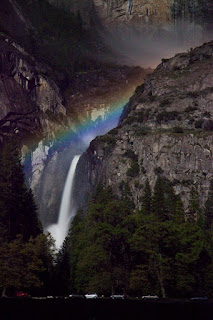 Fortunately if you'd like to know when they're most likely to be visible in Yosemite Valley, Don Olson of the Department of Physics at Texas State University has made it easy for you, publishing predictions for Upper Yosemite Fall and Lower Yosemite Fall.
Fortunately if you'd like to know when they're most likely to be visible in Yosemite Valley, Don Olson of the Department of Physics at Texas State University has made it easy for you, publishing predictions for Upper Yosemite Fall and Lower Yosemite Fall.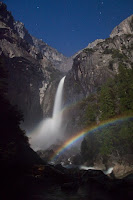 Lower Yosemite Fall from Cook's Meadow.
Lower Yosemite Fall from Cook's Meadow. Moonbow reflected in a vernal pool in Cook's Meadow.
Moonbow reflected in a vernal pool in Cook's Meadow.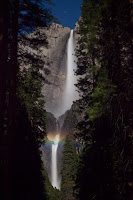 From the short hiking path to the base of Lower Yosemite Fall.
From the short hiking path to the base of Lower Yosemite Fall.
Tuesday, May 12, 2009
Dogwood Season in Yosemite Valley
The dogwood are in full boom in Yosemite Valley, with no new buds apparent. The trees have most of their leaves showing, which can obscure the flowers somewhat (for photography it's best to catch them a little on the early side).
Up at higher elevations the dogwoods are just starting to bloom, with a few early ones showing up in the 5000 to 6000 foot elevations as you leave the Valley South through the Wawona Tunnel and on both sides of Crane Flat. I'd give those areas another week or so.
 The redbud trees are also blooming. For this shot I chose somewhat of a reverse composition, where the framing element is the subject, and what normally would be a strong subject (Lower Yosemite Falls) is a background element to show context.
The redbud trees are also blooming. For this shot I chose somewhat of a reverse composition, where the framing element is the subject, and what normally would be a strong subject (Lower Yosemite Falls) is a background element to show context.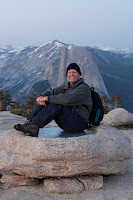 Yosemite National Park's Glacier Point road is open, so I headed up to Sentinel Dome for sunset. Tioga Pass is targeted to open Friday, May 22.
Yosemite National Park's Glacier Point road is open, so I headed up to Sentinel Dome for sunset. Tioga Pass is targeted to open Friday, May 22. 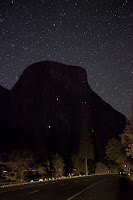 Not the best of my photos, but I thought it was a cool thing to see, so I'm sharing it anyway.
Not the best of my photos, but I thought it was a cool thing to see, so I'm sharing it anyway.I counted at least 9 climbing parties camping out, although their lights were not all visible at once.
I understand that it generally takes at least 2 to 4 days to climb El Capitan. The camps do seem pretty well divided into three levels that a four day, three night climb might require.